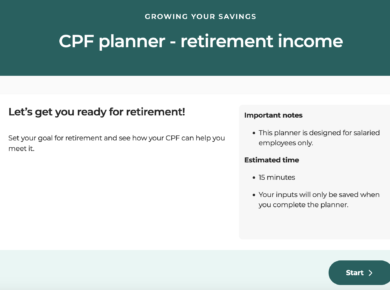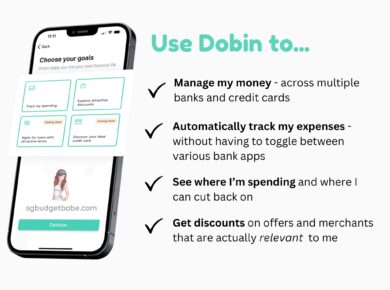The recent economic downturn triggered by COVID-19 resulted in global interest rates being slashed to an all-time low, causing many investors to seek out higher returns in the capital markets. At times like this, I’m glad my CPF continues to generate 2.5 – 5%* annually for me, and I hope that more readers will start to appreciate the basic tenet that CPF plays in every Singaporean’s personal finance game plan.
If you haven’t already mastered your personal finance game plan, here’s what I’d suggest for a start:
1. Cut Your Expenses (eliminate non-essential spending)
The Circuit Breaker has made many of my friends realise that they never really needed stuff like that gym membership when there are so many home fitness options available for free (or for a much reduced fee). They’ve already saved between $70 – $100+ a month without these memberships, and for myself, not having to pay for CBD meals ($8 – $15 mostly) has also saved me a ton on food expenses during this period.
We are not always guaranteed a job, and you can clearly see that when companies are struggling financially, there’s little they can do to retain their employees.
If you continue to live each month from paycheck to paycheck or worse, if you over-leverage, you’re only setting yourself up for failure when your regular income gets cut off (or reduced) suddenly in times like these. This is where an emergency fund can really come in handy.
2. Boost Your Savings and Compound Them
Remember how many FIRE folks were caught off-guard by the recent crisis, some of whom had to come out of early retirement and start working again as a result? Almost ¾ of those due to retire before 2025 were forced to rethink their plans (Fidelity Investor Survey, 2020). The widely-touted 4% withdrawal game plan worked perfectly for retirement…until Covid-19 exposed the flaws in that strategy. Elsewhere around the world, many of the elderly do not even have retirement savings, to begin with, and the recent crisis has made it even harder for them to retire now…much less find work to continue into their 60s or 70s.
Even those who retired and lived off dividends were caught off-guard when even blue-chip stocks like HSBC halted dividends in the wake of the crisis. Clearly, nothing in life (nor the financial markets) is ever guaranteed.
Thankfully, our CPF is, so make sure you play that up to your advantage.
And since CPF is a basic tenet in every Singaporean’s financial game plan, it pays to be savvy about it and manage your CPF well, so that you’ll have less to worry about in retirement.
If you don’t already know, setting aside your Basic Retirement Sum (BRS) or Full Retirement Sum (FRS) sooner rather than later will make a huge difference in your retirement monies i.e. the earlier you reach your target, the more money you’ll have by the time you retire.
I managed to set aside my BRS before turning 30, and got there by utilising a combination of two moves – (i) transfer my funds from my Ordinary Account (OA) to my Special Account (SA) for higher interest, and (ii) making voluntary top-ups to my CPF each year. Check out more details here: ‘3 Moves To Make Your CPF Work Harder For You’
My friend even topped up his child’s CPF account when she was born so that the money can be used to compound at up to 5%* over time. That’s going to give her a significant financial advantage when she grows up!
*Members who are below 55 years old are paid an extra interest of 1% per annum on the first $60,000 of their combined balances (capped at $20,000 for Ordinary Account (OA))
3. Re-examine Your Insurance Coverage
This pandemic has been a good reminder of how there’s nothing more valuable than our health; remember the good old saying of “health is wealth”? Money is probably the last thing you want to worry about when you’ve to deal with such unexpected events in life. Which is why it is so important to review if we have enough coverage for what we need.
Apart from government subsidies across public healthcare settings, Singaporeans are already covered for life under MediShield Life, which protects you from large hospitalisation bills and costly outpatient treatments. We also have our MediSave to pay for our healthcare expenses and health insurance premiums. Of course, there’s also the upcoming CareShield Life, an insurance scheme with lifetime cash payouts to protect against the uncertainty of long-term care costs, especially in the event that one becomes severely disabled. Read more about CPF healthcare coverage for young Singaporeans here.
Of course, if you want higher coverage for the cost of a stay in private hospitals or class B1/A wards in public hospitals, you can consider purchasing additional coverage through a private Integrated Shield Plan (Speak with a financial advisor to find a plan in line with your finances and preferences for hospitalisation coverage). Do not wait until you’re sick to get insurance, as you might not be able to get it approved.
My personal belief is: Outsource your biggest financial risks to an insurer, so you can sleep better at night lest the worst happens.
4. Invest for Your Retirement (and your child’s future)
Finally, once you’ve cut your expenses, increased your savings and gotten your required insurance coverage, you can now look at investing for the long term through other methods such as bonds, stocks, or even alternative asset classes like gold or property. If you are more risk-averse and would prefer a safer “investment tool”, you can consider topping up your CPF instead to earn attractive, yet stable, interest rates.
The priority should first be on investing for your retirement because if you take care of yourself, you’re reducing the future financial burden on your children. That will free up their capital and resources to chase their own dreams without having to worry about how to split their (limited) earnings between themselves, their parents and their own children.
Of course, if you’re savvy enough and start building an investment portfolio for your children early, that can be a huge financial gift to pass them when they turn 21. This exact method is what I am doing for my own child.
In summary, be financially woke and put your money to work for you where it matters.
If you didn’t already have a game plan before this crisis hit, make sure you design yours now.
I hope the above “template” helps you to start thinking about what you want to have in your game plan, and shares some actionable tips on moves you can take now to secure your financial future. I hope that my sharing will help more people to make better, informed decisions on how to manage their CPF funds.
It is easy to gripe about the system in good economic times, but we must remember that CPF is meant to be a long-term tool for our retirement in the first place, and the best way to achieve superior gains is really to allow it to compound over time.
This came out really strongly during the recent economic downturn, where interest rates were slashed across the board and bond yields went down. The high-yield saving accounts were not the only ones affected; even endowment plans offered much lower returns now than the rates given a few months right before the crisis hit.
In times like this, I’m thankful that I have my CPF funds to rely on for retirement.
Disclosure: This post is written in collaboration with CPF.
Psst, did you know you can now follow CPF on Telegram for more useful CPF-related tips? Check it out here @CPFBoard !







